Most of us are familiar with the usual garden foes. Aphids are a common sight, and who hasn’t come across a fungal problem now and then?
But you don’t hear as much about mosaic viruses – especially when it comes to certain brassicas, like cabbages.
The truth is that mosaic viruses are really common. Up to 10 percent of cabbages are infected with this disease. It’s one of the most destructive viral diseases of commercial veggies out there.
So if you haven’t run across this issue yet, chances are you will at some point.
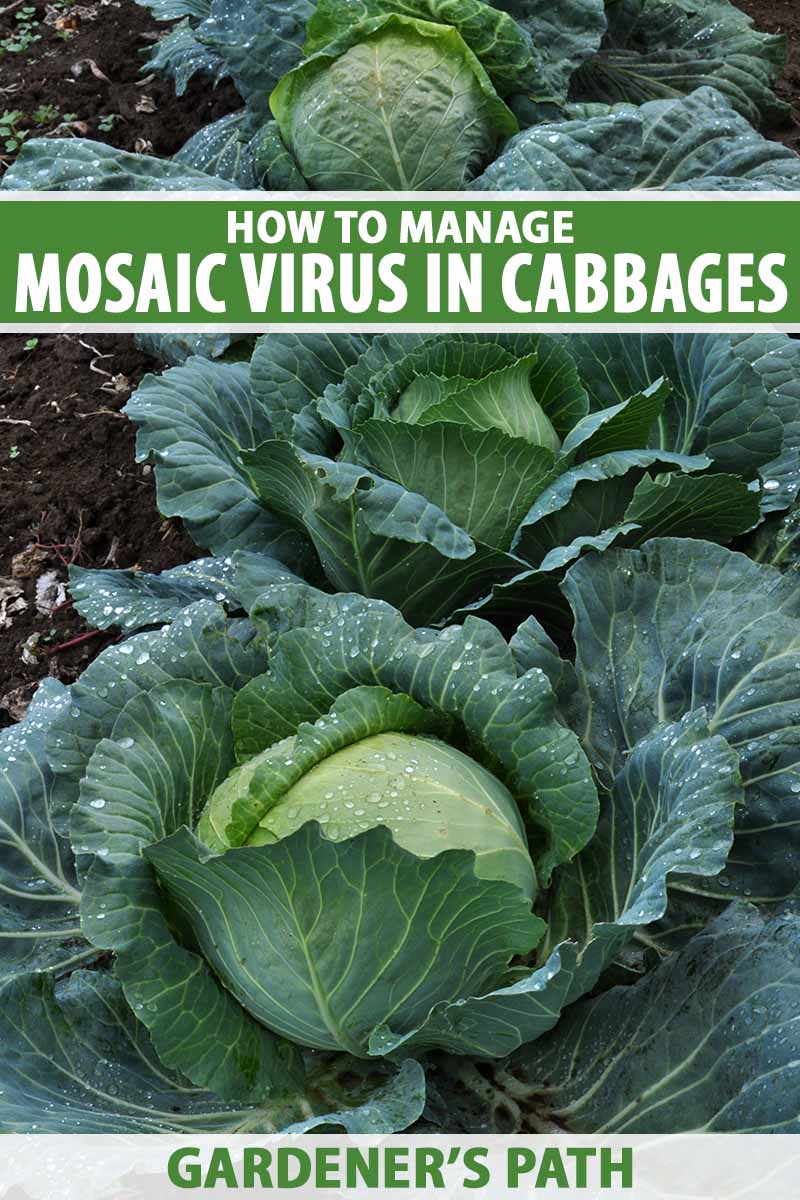
We link to vendors to help you find relevant products. If you buy from one of our links, we may earn a commission.
The problem with these pathogens is that there is no known cure. The best thing you can do is prevent them from taking hold in the first place, and that’s what this guide will help you with.
Here’s what you can expect:
What You’ll Learn
Eager to protect your precious cabbages? Then let’s dig right in!
What Is Cabbage Mosaic Virus?
Before we can begin to deal with mosaic viruses in cabbage, a point of clarification: there is no disease known as “cabbage mosaic virus.”
The mosaic viruses that may impact cabbage are turnip mosaic virus (TuMV), cucumber mosaic virus (CMV), and cauliflower mosaic virus (CaMV).
These pathogens impact brassicas, including cabbage, kale, mustard, and brussels sprouts. TuMV can also impact tobacco and its relatives. CMV can infect nightshades, and a host of other veggies.
All of these cause multiple unpleasant symptoms that range from the ugly to the downright destructive. They can reduce yields, and are spread quite readily.
TuMV is part of the Potyviridae family of viruses which, if you’ve been studying up on your viruses, you know means it is a potyvirus, or a category of plant-specific pathogens that are spread by aphids.
CaMV is part of the Caulimoviridae family. CMV is part of the Cucumovirus family. Aphids spread these, and plants serve as hosts to these types as well.
Because these diseases are primarily spread by aphids, controlling these common pests is key. Seedlings are particularly at risk because symptoms tend to be worse in young plants.
Cauliflower Mosaic Virus Identification
Wondering what your plant will look like if it’s infected with CaMV?
Stunted growth is common, as is a yellow and dark green mottled pattern on the foliage. You might see pale green leaves, with or without translucent veins.
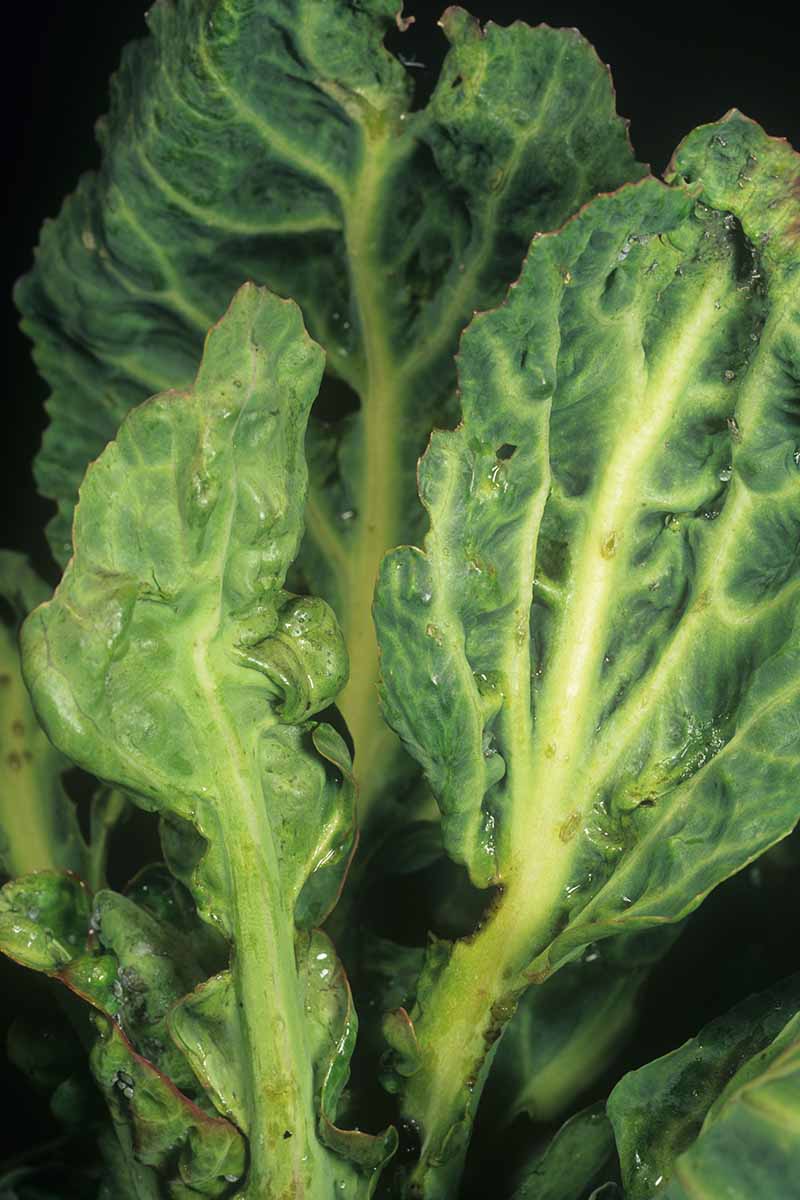
It also causes wart-like growths on the veins and/or the undersides of leaves, and small black spots form on the outer leaves. These spots are often mistaken for pepper spot or black speck.
Cucumber Mosaic Virus Identification
CMV infects hundreds of varieties of plants, mostly brassicas.
When plants are impacted, you will see stunted growth, particularly if a plant is infected when it’s young. The leaves might turn yellow, or show a mottled pattern of light and dark green.
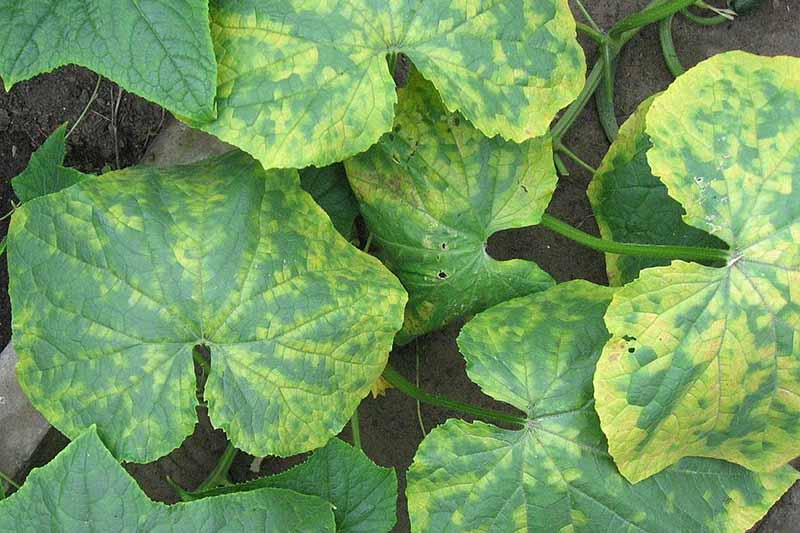
In addition to brassicas, this disease impacts nightshades like peppers and tomatoes, as well as lettuce, celery, and endive.
Turnip Mosaic Virus Identification
This type is more common in cabbage than CaMV. When your cabbage is infected, you may start to see dead spots form on the outer portion of the leaves. These spots then start developing on the interior as well.
The spots resemble ringspot, which means they have a gray or brown interior and a yellow halo – that’s the reason why this disease is sometimes called cabbage ringspot, in fact. These eventually turn black.
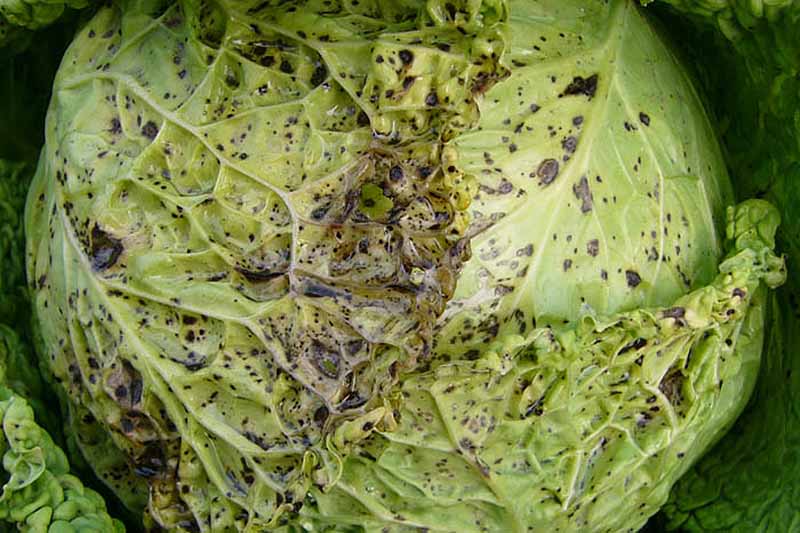
The leaves may also develop a mottled pattern, with patches of yellow, light green, and dark green.
Infected leaves may die and fall off the plant.
Even worse, you may not know your plants have this problem until you put your big, beautiful heads into the cold cellar or refrigerator, and then come back later to slice them up for dinner.
The interior leaves will be full of holes and mottling, and they might be rotten.
The severity and symptoms of the disease depend on the timing of the infection. If a young seedling or transplant is infected, the plant might be stunted and yields dramatically reduced.
Cabbages that are infected later in their growth period are generally lightly impacted with just spots and some mottling developing, but no reduction in overall plant size.
Control Tips
In contrast to some other vegetable viruses out there, mosaic types aren’t spread through seed, so dealing with insect infestations is the best available method of control.
Because aphids are the most common vector for the spread of these diseases, you have to do what you can to keep them away from your plants.
If you’re struggling with aphids, we have a guide that can help you to prevent infestations of these common pests.
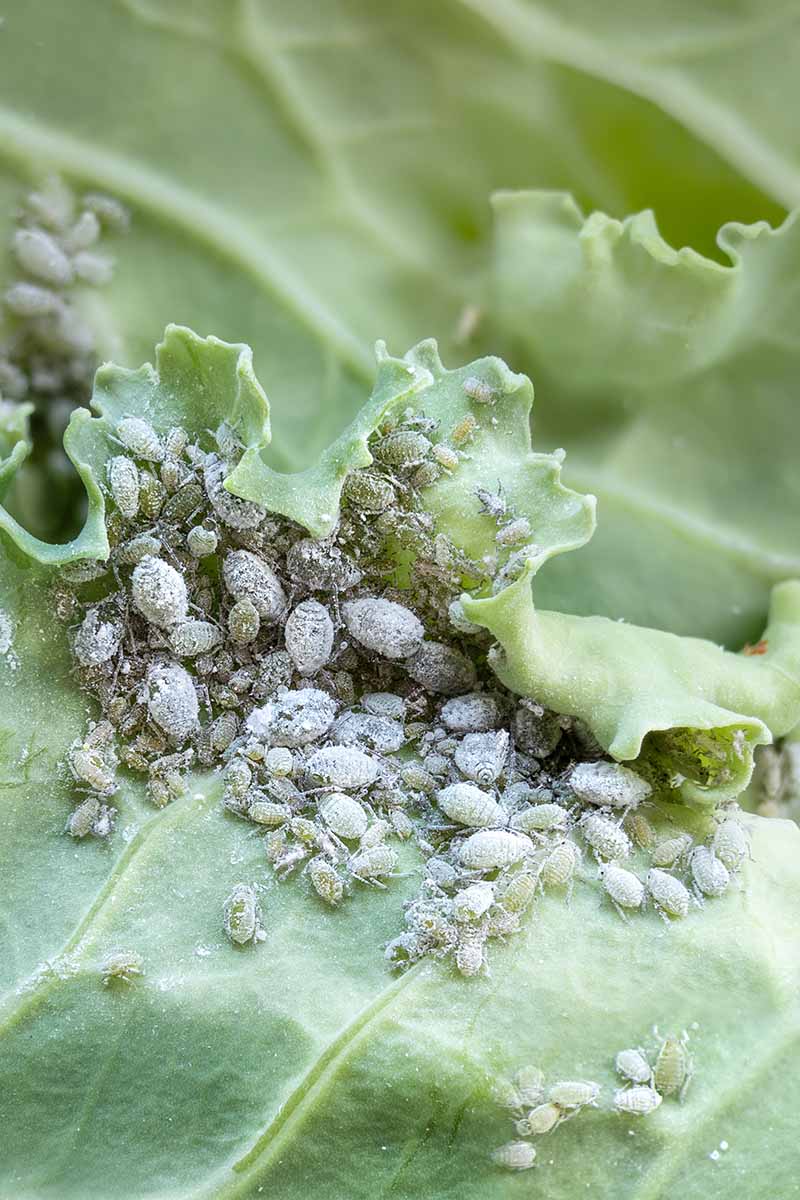
However, be aware that elimination isn’t an effective method of control, since aphids carry the virus in their mouthparts and all it takes is one bite to spread the disease.
There are two species of aphids that prefer brassicas over other plants. These are the cabbage aphid (Brevicoryne brassicae) and the turnip aphid (Lipaphis erysimi).
That said, these diseases may be spread by nearly 100 species of aphids, so chances are, if you see one of these sapsuckers on your plant it could be a carrier.
Most aphids reproduce and thrive in dry, warm weather, so this disease tends to appear more often when those conditions are present.
One method you might try is to plant cereals or mustards on the exterior of your garden. This is known as trap cropping.
The same aphids that spread this disease are attracted to cereals like wheat, barley, and oats as well as mustards, so they’ll likely stop at these tasty options first rather than continuing on to your cabbage plants.
Another surefire method of aphid prevention is to use floating row covers to prevent them from landing on your plants.
You should also do your best to keep weeds out of the garden, since these can serve as primary sources of infection.
Weeds in the brassica family are particularly troublesome, as they can harbor the virus. It also helps to rotate crops every year or every few years, so plants that play host to these diseases aren’t a constant presence in the garden.
The disease can also be spread by tools that you’ve used on infected plants, so be sure to clean your trowels, pruners, and anything else that you’ve worked with, using a mixture of one part bleach to nine parts water between each plant.
In fact, if you’re certain that you’ve been in an area infected with mosaic, you should change your clothes, including your shoes and gloves, before entering another area. The bottoms of your shoes can be sanitized as well.
You should also wash your hands (particularly if you aren’t using gloves) with soap and hot water when you move from one part of your garden to the next.
Now, here’s the bad news:
Once you have this problem in your garden, there’s nothing you can do about it. You’ll have to pull your plants and dispose of them. You can’t even put them in the compost pile.
While you could leave them in the garden and hope that they thrive long enough to provide you with a meal, you run the very real risk of spreading the disease not only to many other plants in your garden, but to your neighbors’ gardens as well.
Remember, these pathogens don’t just impact cabbage. They can infect anything in the Brassicaceae family, as well as tobacco and its relatives.
There is a little good news. In case you were wondering, there isn’t any evidence that eating a plant infected with these pathogens is dangerous to humans, so you can eat the heads you’ve been forced to pull if they aren’t too damaged.
Resistant Varieties
To give your garden an extra fighting chance against this problem, consider planting resistant cultivars.
Danish cultivars such as ‘Danish Ballhead’ have been found to show some resistance to mosaic viruses.
‘Bently,’ ‘Impala,’ and ‘Tenderheart’ have also shown resistance to TuMV.
Keep Mosaic Viruses Out of Your Cabbage Patch
As you can see, it’s not Peter Rabbit who you have to worry about ruining your cabbage patch (okay, you should still watch out for hungry bunnies…), it’s one of the deadly mosaic viruses that may pay a visit if you’re not careful.

If you’ve ever faced one of these viral foes before, what method of control did you opt for? Did row covers help? Rotating out brassicas for a few years? Or maybe a combination? Let us know in the comments below.
Hopefully, this guide made you feel like you could successfully prevent these viruses in your garden. If so, expand your knowledge of cabbage-growing with these helpful guides: